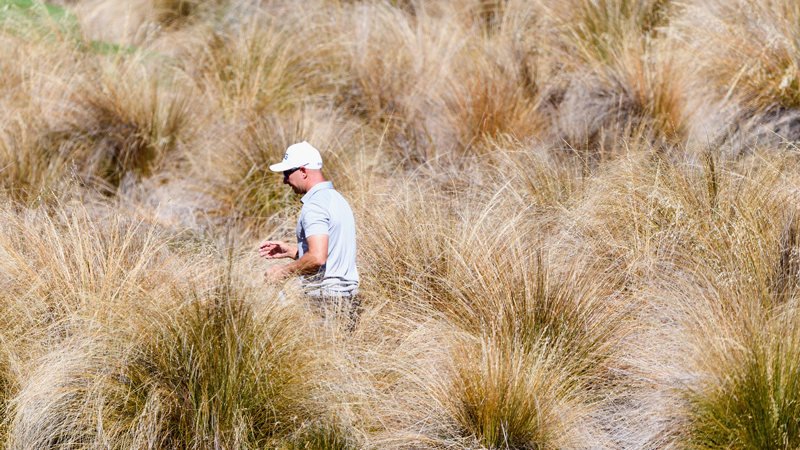Should More Areas Of Rough Or Woodland Be Marked As Penalty Areas?
GM regulars Fergus Bisset and Jeremy Ellwood tackle both sides of the argument


GM regulars Fergus Bisset and Jeremy Ellwood debate whether it would be a sensible move for more areas of rough or woodland to be marked as penalty areas.
Should More Areas Of Rough Or Woodland Be Marked As Penalty Areas?
Yes
says Fergus Bisset
The argument for the affirmative is as an obvious method of realising a current key aim within almost all golfing circles – the expedition of play.
How irritating is it for you, or even the group in front of you, to unexpectedly lose a ball in rough or woodland?
In competition golf, it often means a walk back to the tee, or previous hitting spot, a let-through and a hold-up right through the field.
Subscribe to the Golf Monthly newsletter to stay up to date with all the latest tour news, equipment news, reviews, head-to-heads and buyer’s guides from our team of experienced experts.
If the area the ball is lost in is marked as a penalty area, there’s no such problem. Simply an agreement with partners it’s “virtually certain” the ball been lost in the penalty area and a drop where it last crossed the edge.
More penalty areas would also speed play from the tee.
If a ball has veered offline into rough that’s known to be marked as a penalty area, no provisional ball would be required, saving a minute of preparation and hitting.
And on blind shots, when you assume all is fine only to discover the ball has run through the fairway into rough or bushes, play could continue with ease.
When the rough is thick, marking it as a penalty area could be a round-saver for amateur golfers, even if they find the ball.
If they locate it in the knee-high cabbage, with no obvious spot to take an unplayable or drop back on line, they might attempt to blast out, rather than face a walk back to the previous hitting area.
In so doing, they could exacerbate their problem (taking multiple hacks and minutes to fail to extricate themselves.)
But if it was a penalty area, they would have a clear spot to drop and carry on with their round.
To speed up play and to give amateur golfers another option to keep a score going, more areas of rough and woodland should be marked as penalty areas.
Should More Areas Of Rough Or Woodland Be Marked As Penalty Areas?
No
says Jeremy Ellwood
Although the switch from water hazards to penalty areas in 2019 broadened things out from simply areas of water, I doubt the intention was ever for countless areas of rough or woodland to become penalty areas.
The R&A’s explanation was that it would “allow committees to respond to the wide range of settings in which golf is played by giving relief from areas that present similar obstacles to existing water hazards,” citing deserts, jungles and lava rock fields as examples – i.e. things you find on courses in other parts of the world.
Yes, it can be broader than that, and there could be pace-of-play arguments, but the committee procedures for course markings on The R&A website contains nearly 500 words under the header: ‘Deciding when to mark area that does not contain water as penalty area’.
This suggests to me that they don’t want committees going to town with the red paint and marking every slightly unsavoury spot as a penalty area.
Among the things mentioned are retaining the challenge of a hole, and keeping things reasonably consistent throughout the course – i.e. why should one area of vegetation be marked as a penalty area and not another?
It also urges caution when considering converting OOB to a penalty area, as the latter doesn’t demand obligatory stroke and distance, and that could upset the balance of the course rating for handicap purposes.
Finally, The Grove in Hertfordshire used to have – and may still have – a ‘long rough rule’, effectively allowing you to treat areas of long rough as a penalty area.
I could never bring myself to take advantage of that liberal interpretation, and for similar underlying reasons, wouldn’t want to see vast areas of our courses marked up as penalty areas today.

Fergus is Golf Monthly's resident expert on the history of the game and has written extensively on that subject. He has also worked with Golf Monthly to produce a podcast series. Called 18 Majors: The Golf History Show it offers new and in-depth perspectives on some of the most important moments in golf's long history. You can find all the details about it here.
He is a golf obsessive and 1-handicapper. Growing up in the North East of Scotland, golf runs through his veins and his passion for the sport was bolstered during his time at St Andrews university studying history. He went on to earn a post graduate diploma from the London School of Journalism. Fergus has worked for Golf Monthly since 2004 and has written two books on the game; "Great Golf Debates" together with Jezz Ellwood of Golf Monthly and the history section of "The Ultimate Golf Book" together with Neil Tappin , also of Golf Monthly.
Fergus once shanked a ball from just over Granny Clark's Wynd on the 18th of the Old Course that struck the St Andrews Golf Club and rebounded into the Valley of Sin, from where he saved par. Who says there's no golfing god?